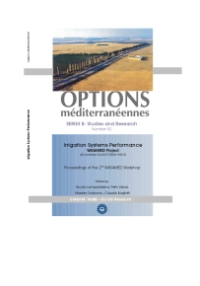| Article précédent | p. 31-48 | Article suivant |
Multi-criteria analysis for improved water use and saving in a large surface irrigation district
This paper refers to a field and modelling study performed in a large surface irrigation system in the upper Yellow River Basin. The irrigation scheduling simulation model ISAREG was used to evaluate the current irrigation schedules and to generate improved ones. Capillary rise from the water table, deep percolation, leaching requirements and impacts of salinity in crop evapotranspiration, crop water stress and yields were considered. Field evaluations of farm irrigation systems were performed to parameterise the surface irrigation model SRFR, which was used to generate improved basin irrigation scenarios. Both models were explored interactively to create a complete set of demand scenarios used with the SEDAM model. SEDAM is a DSS tool that allows evaluating impacts of improvements in farm and off-farm irrigation canal systems. Irrigation scheduling improvements consist in reducing the number of irrigations and adopting new calendars in accordance with the water table depth and soil salinity. Surface irrigation improvements consist of improving land levelling and increasing the inflow rates by unit width.
- [ Afficher ]
- [ Télécharger ]
- [ Exporter la citation ]
Vous pouvez télécharger la citation au format :
- [ Imprimer ]
-
Mots-clés
CALENDRIER DES IRRIGATIONS, ECONOMIE DE L'EAU, IRRIGATION PAR CUVETTE, RESEAU D'IRRIGATION, UTILISATION DE L'EAUCiter cet article
Gonçalves J.M., Pereira L.S. Multi-criteria analysis for improved water use and saving in a large surface irrigation district. In : Lamaddalena N. (ed.), Lebdi F. (ed.), Todorovic M. (ed.), Bogliotti C. (ed.). Irrigation systems performance. Bari : CIHEAM, 2005. p. 31-48. (Options Méditerranéennes : Série B. Etudes et Recherches; n. 52). 2. WASAMED Workshop: Irrigation Systems Performance, 2004/06/24-28, Hammamet (Tunisia). http://om.ciheam.org/om/pdf/b52/05002246.pdf



